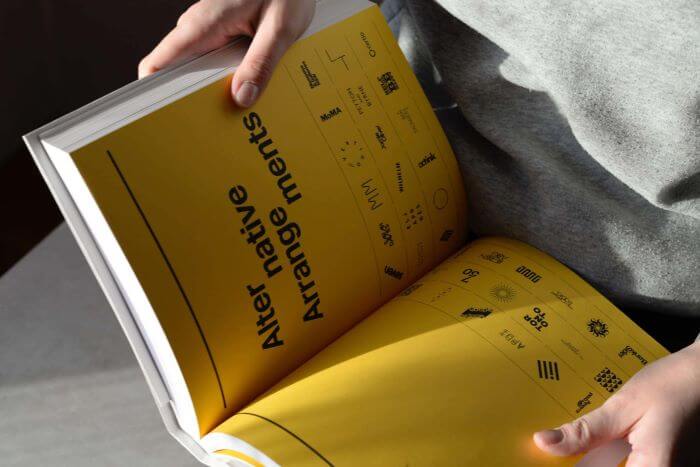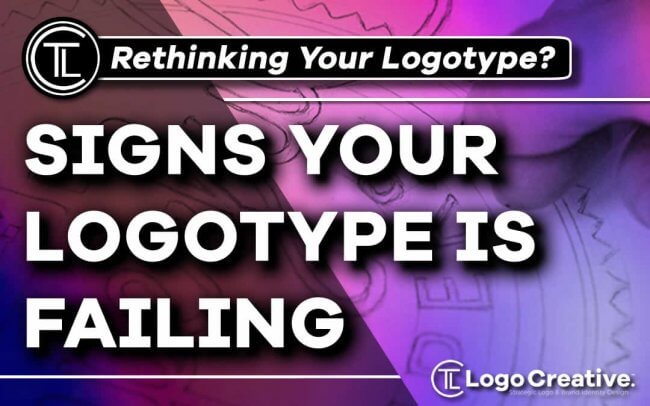When it comes to your branding, a logotype design can make a huge difference. By conveying your brand message through your logotype, you ensure that you reach the right customers and develop a distinct brand identity. Keep on reading to learn about 5 Signs Your Logotype is Failing, and more about good logotype design.
Your logo is everything when you represent your brand. Whether you run a bookshop or work in a trade, your logo is a way to draw customers in and show them who you are.
Designing the perfect logotype is one of the most important jobs that you can do as a company.
Think about how many great brands you can name off the top of your head? If you test out this simple exercise, you will probably notice that the first ones that spring to mind have something in common.
They probably all have a memorable logotype or logomark!
Creating a great logotype design takes work and consideration. There are lots of factors that can make the difference between a logotype that stands out, and one that fades into the background.
So, how do you know if you have the right logotype for your brand? How can you successfully change the brand direction if you feel that your logotype is failing?
We’ll look at some of the things you can do if you feel that your logotype isn’t up to the job!
Table of Contents
What Is a Logotype?

The best logo design is one that communicates succinctly with the customer. Customers should be able to look at your logo and instinctively learn certain things about your brand.
So, what is a logotype versus other logo designs, such as logomarks? Simple! A logotype is a logo design written in text. A logomark, in contrast, is an image or symbol associated with your brand.
For some great logotype examples, look at hyper-successful brands such as Coca-Cola or Sony. These brands don’t use any imagery in their logos. Instead, everything you need to know about their brands is communicated through careful design choices in terms of font and logo-type colours.
What Are the Benefits of a Logotype Compared With Logomarks?
Think a piece of plain old text is too boring for your company? Thanks again! In fact, there are lots of benefits in choosing a logotype design over an image or symbol.
For one, logotypes work well on appliances or pieces of hardware. Think of a logotype like Bosch or Toyota as examples. Logotypes also keep your brand name at the forefront of the customer’s mind.
While symbols such as logos can also work well, they are usually accompanied by a piece of text anyway. Text is
the explanatory part of your logo. It literally tells people who you are. A symbol won’t do this as effectively unless your brand is already well known, or you have put a huge amount of work into perfecting it.
If you’re a smaller company or just starting, it never hurts to have your name out there on your products. This gives you the flexibility to combine or replace your logotype with a logomark as time goes on.
Think, for example, of companies like Amazon, who used to be primarily known by a logotype, but who now mainly go by their symbolic ‘a’ logomark.
How To Understand If Your Logotype Design Isn’t Up to Scratch?

Sometimes, even when we work hard on a design, it might not perform the way we expect. There are several jobs where a great logotype should perform:
- Your logotype should be attractive and eye-catching.
- Your logotype should communicate your brand image to your target audience.
- Your logotype should stand out, regardless of the visual context that surrounds it.
If you suspect that your logotype isn’t hitting these marks, here are some of the signs to watch out for:
-
Your Font is Hard to Read
Wondering about the types of logotypes that would work best for your business? Even a simple logotype is enough to catch the eye if it’s placed in the appropriate context.
Believe it or not, there are plenty of branding experts who can tell you a lot about choosing the right font for your logo text.
For example, do you plan to place your logomark in an online context such as a website or online platform? Or will your logo mainly exist on hardware or be imprinted on physical items? Depending on the context, your font requirements could change quite a lot.
Some fonts, for example, are simply easier to read digitally. A popular example of this would be Sans Serif fonts, which translate well online and are easier on the eyes. Some great options for digital logotypes include Helvetica, Source Sans Pro, or Gill Sans.
In contrast, Serif fonts, like Times New Roman and Bondoni, show up better on paper or physical items. Look at Sony’s Serif-tipped letters in their logo text. Or Coca-Cola’s swirly script.
These decorative flourishes work well in the context of physical items because the eye can process them better on a 3D surface, rather than a screen. It’s definitely something to think about when looking for logotype inspiration.
-
Your Logotype Doesn’t Stand Out
Fundamentally, what your logotype looks like doesn’t matter if it doesn’t do the most important job. Catch the customers’ eye! Your logotype is important as a visual ambassador for your brand. If it’s forgettable or blends in easily with other logos, put it on the scrap pile and start brainstorming again.
-
It Can’t Be Reproduced on Any Background
As well as being eye-catching, you have to think of your logotype in terms of its ability to be replicated across a range of products. You should consider your brand when choosing a logotype design.
For example, is this a logotype for designers which needs to stand out on both your online page and as an emblem on your prints? Or is this a logotype for a physical product or piece of hardware?
Depending on what you produce, you should plan your logotype to fit your product. Think about how the colours will work on your product surface. Will they look sleek or overly busy?
Will the logotype colours invert well if you want to place a white logo onto a white piece of paper, for example? These considerations should all be a major part of your design process when engineering a great logotype.
-
Your Logotype Does Not Connect to Your Brand
To design a logotype with meaning, you need to think carefully about your brand and products. Who is it for? Why do they want it? What message about the items they will want to send by purchasing your items? If you cannot answer these questions, you aren’t yet ready to start designing your logotype.
Many people get carried away when they first start working on their logo design. Instead of thinking about how to represent their brand specifically, they get carried away working from famous examples. This is perfectly normal.
However, it will need to be corrected if you want your brand to succeed.
Instead of working from a marketer’s handbook of what other companies do, shift the focus onto who your target customer is. If you can imagine your logotype design fitting in with other products that they have around their house, then you could be a winner. If not, it could be time to go back to the drawing board.
-
Choose Font for Feeling
So, you’ve thought about who your customer is, but something still feels off? It’s time to change perspective. Who are you and what is your brand story?
Creating a logotype for branding isn’t much different than constructing any other part of your brand image.
Again, we go back to the question of the font. Some fonts connect better to certain brand stories than others. For example, a handwritten script font conveys feelings of youthfulness, authenticity, and charm.
This is a good logotype option to choose from if you want to appeal to younger buyers who value authenticity primarily above expertise or brand longevity.
In contrast, if you want to convey a sense of expertise and industry knowledge, a more formal font is advised. A Serif font gives a sense of officiality which can appeal to older clients.
Older clients tend to value expertise and tradition. They are less likely to mind if your logo is missing a personal touch and are more likely to take it seriously if it fits their values and mindset. These titbits of knowledge are vital to know when trying to find a logotype that fits your unique brand story.
Conclusion
Can logotype design make that much difference to the success of your company? Absolutely. Even though famous companies may make branding seem effortless, rest assured that a huge amount of thought and energy goes into even minor details.
Take this detailed approach with your brand and be sure to come out on top!
Final Call: What are some of your favourite brand logotypes? How do they inspire you in your brand work? Have you ever designed a logotype then had to scrap it and start again? Let us know in the comments!
Join The Logo Community
We hope you enjoyed these 5 Signs Your Logotype is Failing. If you would like more personal tips, advice, insights, and access to our community threads and other goodies, join us in our community.
Learn from our Founder Andrew who personally writes our community newsletter. You can also comment directly on posts and have a discussion.
*TIP – Looking to learn logo design? We recommend the Logo Design Online Masterclass, it will teach you how to plan, design and execute logo designs. The course has also had great feedback from the design community.
Author bio
Arthur Rowley is a freelance writer. He mainly specializes in technology and design. Arthur likes everything to do with technology and video games. He looks into the future of technology and is very excited about its daily metamorphosis and hopes in the future for what lies behind the curtain of technological development. He currently works with el torero


